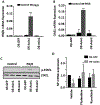Axin1: A novel scaffold protein joins the antiviral network of interferon
- PMID: 36308071
- PMCID: PMC9789182
- DOI: 10.1111/mmi.14995
Axin1: A novel scaffold protein joins the antiviral network of interferon
Abstract
Acute respiratory infection by influenza virus is a persistent and pervasive public health problem. Antiviral innate immunity initiated by type I interferon (IFN) is the first responder to pathogen invasion and provides the first line of defense. We discovered that Axin1, a scaffold protein, was reduced during influenza virus infection. We also found that overexpression of Axin1 and the chemical stabilizer of Axin1, XAV939, reduced influenza virus replication in lung epithelial cells. This effect was also observed with respiratory syncytial virus and vesicular stomatitis virus. Axin1 boosted type I IFN response to influenza virus infection and activated JNK/c-Jun and Smad3 signaling. XAV939 protected mice from influenza virus infection. Thus, our studies provide new mechanistic insights into the regulation of the type I IFN response and present a new potential therapeutic of targeting Axin1 against influenza virus infection.
Keywords: Axin1; JNK/c-Jun; Smad3; influenza virus; interferon.
© 2022 John Wiley & Sons Ltd.
Conflict of interest statement
Conflict of Interest:
The authors have no conflict of interest to declare
Figures







Similar articles
-
Type I and Type III Interferons Restrict SARS-CoV-2 Infection of Human Airway Epithelial Cultures.J Virol. 2020 Sep 15;94(19):e00985-20. doi: 10.1128/JVI.00985-20. Print 2020 Sep 15. J Virol. 2020. PMID: 32699094 Free PMC article.
-
Contrasting interferon-mediated antiviral responses in human lung adenocarcinoma cells.J Virol. 2025 Jun 17;99(6):e0046925. doi: 10.1128/jvi.00469-25. Epub 2025 May 28. J Virol. 2025. PMID: 40434103 Free PMC article.
-
METTL3 depletion blocks vesicular stomatitis virus replication in pancreatic cancer cells through the establishment of an intrinsic antiviral state.J Virol. 2025 May 20;99(5):e0228424. doi: 10.1128/jvi.02284-24. Epub 2025 Apr 11. J Virol. 2025. PMID: 40214229 Free PMC article.
-
Physical interventions to interrupt or reduce the spread of respiratory viruses.Cochrane Database Syst Rev. 2023 Jan 30;1(1):CD006207. doi: 10.1002/14651858.CD006207.pub6. Cochrane Database Syst Rev. 2023. PMID: 36715243 Free PMC article.
-
Pharmacological interventions for acute hepatitis C infection: an attempted network meta-analysis.Cochrane Database Syst Rev. 2017 Mar 13;3(3):CD011644. doi: 10.1002/14651858.CD011644.pub2. Cochrane Database Syst Rev. 2017. Update in: Cochrane Database Syst Rev. 2018 Dec 03;12:CD011644. doi: 10.1002/14651858.CD011644.pub3. PMID: 28285495 Free PMC article. Updated.
Cited by
-
Axin1's mystique in manipulating microbiome amidst colitis.Gut Microbes. 2023 Dec;15(2):2286674. doi: 10.1080/19490976.2023.2286674. Epub 2023 Nov 27. Gut Microbes. 2023. PMID: 38010886 Free PMC article.
-
The therapeutic potential of RNA m(6)A in lung cancer.Cell Commun Signal. 2024 Dec 31;22(1):617. doi: 10.1186/s12964-024-01980-5. Cell Commun Signal. 2024. PMID: 39736743 Free PMC article. Review.
-
Air pollution-induced proteomic alterations increase the risk of child respiratory infections.Nat Commun. 2025 Jul 1;16(1):5930. doi: 10.1038/s41467-025-61392-y. Nat Commun. 2025. PMID: 40595623 Free PMC article.
-
The use of human iPSC-derived alveolar organoids to explore SARS-CoV-2 variant infections and host responses.J Med Virol. 2024 Apr;96(4):e29579. doi: 10.1002/jmv.29579. J Med Virol. 2024. PMID: 38572923 Free PMC article.
-
The scaffold protein AXIN1: gene ontology, signal network, and physiological function.Cell Commun Signal. 2024 Jan 30;22(1):77. doi: 10.1186/s12964-024-01482-4. Cell Commun Signal. 2024. PMID: 38291457 Free PMC article. Review.
References
Publication types
MeSH terms
Substances
Grants and funding
LinkOut - more resources
Full Text Sources
Medical
Research Materials
Miscellaneous

